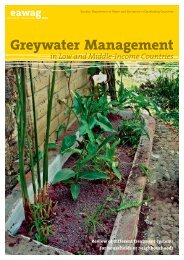Household Water Treatment and Safe Storage Factsheet: Source ...
Household Water Treatment and Safe Storage Factsheet: Source ...
Household Water Treatment and Safe Storage Factsheet: Source ...
Create successful ePaper yourself
Turn your PDF publications into a flip-book with our unique Google optimized e-Paper software.
<strong>Household</strong> <strong>Water</strong> <strong>Treatment</strong> <strong>and</strong> <strong>Safe</strong> <strong>Storage</strong><br />
Fact Sheet: Bios<strong>and</strong> Filter<br />
Cross Section of Plastic Bios<strong>and</strong> Filter<br />
(Credit: TripleQuest)<br />
Operation<br />
Contaminated water is poured into the top of<br />
the filter on an intermittent basis. The water<br />
slowly passes through the diffuser, <strong>and</strong><br />
percolates down through the biolayer, s<strong>and</strong><br />
<strong>and</strong> gravel. Treated water naturally flows<br />
from the outlet pipe.<br />
The biolayer is the key pathogen removing<br />
component of the filter. Without it, the filter is<br />
significantly less effective. It may take up to<br />
30 days to establish the biolayer depending<br />
on inlet water quality <strong>and</strong> frequency of use.<br />
The water from the filter can be used during<br />
the first few weeks while the biolayer is<br />
being established, but disinfection is<br />
recommended during this time, as during<br />
regular on-going use.<br />
The biolayer requires oxygen to survive.<br />
When water is flowing through the filter,<br />
dissolved oxygen in the water is supplied to<br />
the biolayer. During pause times, when the<br />
water is not flowing, the oxygen is obtained<br />
by diffusion from the air.<br />
Correct installation <strong>and</strong> operation of the<br />
bios<strong>and</strong> filter has a water level of<br />
approximately 5 cm above the s<strong>and</strong> during<br />
the pause period. A water depth of greater<br />
than 5 cm results in lower oxygen diffusion<br />
to the biolayer. A water depth less than 5 cm<br />
may evaporate quickly in hot climates <strong>and</strong><br />
cause the biolayer to dry out.<br />
A pause period is needed between uses to<br />
allow time for the microorganisms in the<br />
biolayer to consume pathogens in the water.<br />
Users should wait at least one hour after all<br />
the water has been filtered before filling the<br />
filter again. It is recommended to use the<br />
filter every day; however users can wait up<br />
to a maximum of 48 hours between batches.<br />
The bios<strong>and</strong> filter has been designed to<br />
allow for a filter loading rate (flow rate per<br />
square metre of filter area) which has<br />
proven to be effective in laboratory <strong>and</strong> field<br />
tests. This filter loading rate has been<br />
determined to be not more than 600<br />
litres/hour/square metre.<br />
The recommended flow rate for the CAWST<br />
Version 10 concrete bios<strong>and</strong> filter is 0.4<br />
litres/minute measured when the inlet<br />
reservoir is full of water. If the flow rate is<br />
much faster, the filter may become less<br />
efficient at removing pathogens. If the flow<br />
rate is much slower, the user may become<br />
impatient <strong>and</strong> not use the filter even though<br />
the filter is working well at removing<br />
pathogens. Since the flow rate is controlled<br />
by the size of the s<strong>and</strong> grains, it is very<br />
important to select, sieve <strong>and</strong> wash the s<strong>and</strong><br />
properly.<br />
The flow rate through the filter will slow<br />
down over time as the biolayer develops <strong>and</strong><br />
sediment is trapped in the upper layer of the<br />
s<strong>and</strong>. For turbidity levels greater than 50<br />
NTU, the water should first be strained<br />
through a cloth or sedimented before using<br />
the BSF.<br />
The bios<strong>and</strong> filter requires maintenance<br />
when the flow rate drops to a level that is<br />
inadequate for the household use. This is<br />
done by a simple ‘swirl <strong>and</strong> dump’ procedure<br />
performed on the top of the s<strong>and</strong>, <strong>and</strong> only<br />
takes a few minutes.<br />
The outlet should also be cleaned regularly<br />
using soap <strong>and</strong> water or a chlorine solution.<br />
The treated water should be collected by the<br />
user in a safe storage container placed on a<br />
block or st<strong>and</strong>, so that the container opening<br />
is just under the outlet, minimizing the risk<br />
for recontamination.
















